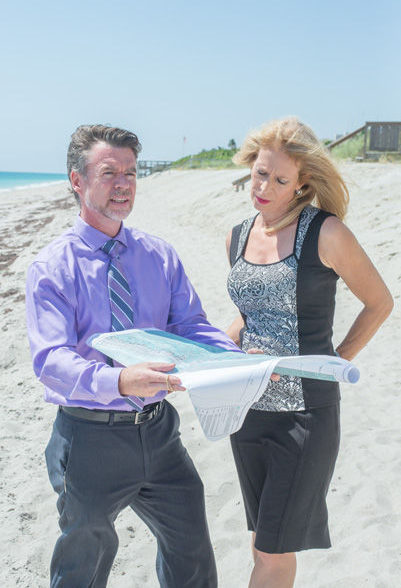
INDIAN RIVER COUNTY — Denise Boehning spends hours on end sitting at her cherry wood desk in her office, looking over maps of Indian River County that show what areas are in what flood zones.
The reason: As a certified flood plain manager and president of CoastalWide Flood Map Revisions, her job is to figure out what properties have erroneously been placed in flood hazard zones, forcing the owners to pay more than they should for flood insurance.
And then her job is to do the paperwork to get them officially removed from flood zone designations so that their flood insurance rates are lowered.
With the recent and dramatic escalation of flood insurance rates in Florida caused by the near collapse of the National Flood Insurance Program, which previously subsidized flood insurance rates, Denise Boehning’s skills are in more demand than ever.
What bothers her, though, is seeing a lot of properties in Indian River County that she suspects have been wrongly categorized, but the owners don’t know it and continue to pay increasing flood insurance rates.
Most of Boehning’s eureka moments, while studying the maps, come when she finds a property out of a flood zone next to a property in a flood zone.
“We see cases of people paying $2,000 while their neighbors pay $200,” she said.
“This happens because FEMA (the Federal Emergency Management Agency that drew the flood maps) sometimes glosses over survey data that contradicts what the map shows,” explained her husband, Steve Boehning, a coastal engineer who works with her.
“FEMA tends to draw a line and say everything in this area is in a flood zone because they don’t have the manpower to check it out. But the Boehnings check it out, ” said Vero Insurance risk advisor Joe Chiarella, who said he saw insurance for a group of condos recently go from $400,000 to $50,000 a year after the Boehnings got the property removed from a flood zone.
While Chiarella won’t say what condo it was, the Boehnings got the luxury condos at Carlton, on the north end of the barrier island, removed from a flood zone several years ago.
“I can’t say what the insurance savings was because our residents are very private, but I can say it was enough to make people here very happy,” said Carlton manager Doug Distl.
The Boehnings have also gotten hundreds of homes on the mainland removed from flood zones, including multiple homes in the Cypress Lake, Ashley Lakes, and Grove areas.
First, Denise asks property owners, who are hoping to be removed from flood zones, if they have a “certificate of elevation,” which may be the only proof she needs to get them out of a flood zone.
But if they don’t have a certificate, Steve works with surveyors to get one, and also runs models to learn how strong the wave and wind velocity could be in a hurricane for a property on or near the water.
With that information in hand, Denise applies to the county for “a letter of community acknowledgment” to accompany the application to FEMA for a different designation.
To apply to FEMA usually costs $425 for a single home and $800 total for multiple homes.
“If at any point in the process we think FEMA won’t approve the application, we stop,” said Denise, who, like her husband, only gets paid if the FEMA application is successful and she and Steve take a percentage of the insurance savings from the property owner.
“In my experience the Boehnings have been successful with FEMA 100 percent of the time,” said insurance agent Chiarella.
County land development manager David Hays said that last year Indian River County received 300 to 400 applications – most following the work the Boehnings did – for community acknowledgment letters to accompany FEMA applications to be removed from flood zones.
“Out of hundreds, only one application was rejected by us before going to FEMA, and that had nothing to do with the Boehning’s work,” said Hays.
On a conference table in the public works department, Hays unfurls a large map that shows county flood zones and points to a squiggly line that snakes across them delineating properties in flood zones from those out of them.
“Properties get lumped in and categorized together. But the flood lines weave in and out,” said Waddell & Williams insurance agent Patrick Hopkins, who like Chiarella, works with the Boehnings to get flood insurance rates lowered for his customers.
Unlike the county, the City of Vero Beach has only had about three applications to be removed from flood zones in the past five years, said the city’s chief surveyor David Gay.
But the Boehnings say they have been looking at properties – hotels, restaurants and condos – on and near the ocean in Central Beach and think applications to be removed from flood zones would increase in the city if property owners saw what they’re seeing.
Also, Denise has recently been studying homes on the ocean to the south of Carlton in John’s Island and suspects they are wrongly zoned.
“People think if they’re on the ocean there is nothing they can do, but they’re wrong,” she said.
In fact, Denise said she thinks the Pelican Plaza building on the barrier island where Vero Beach 32963 and VeroNews are located is probably also wrongly categorized as being in a flood zone.
From start to finish, the process to get removed from a flood zone takes 120 days, ending when FEMA sends the property owner the new designation, which then goes to the insurance agent.
“And we move quickly to lower the rates,” said insurance agent Hopkins.



